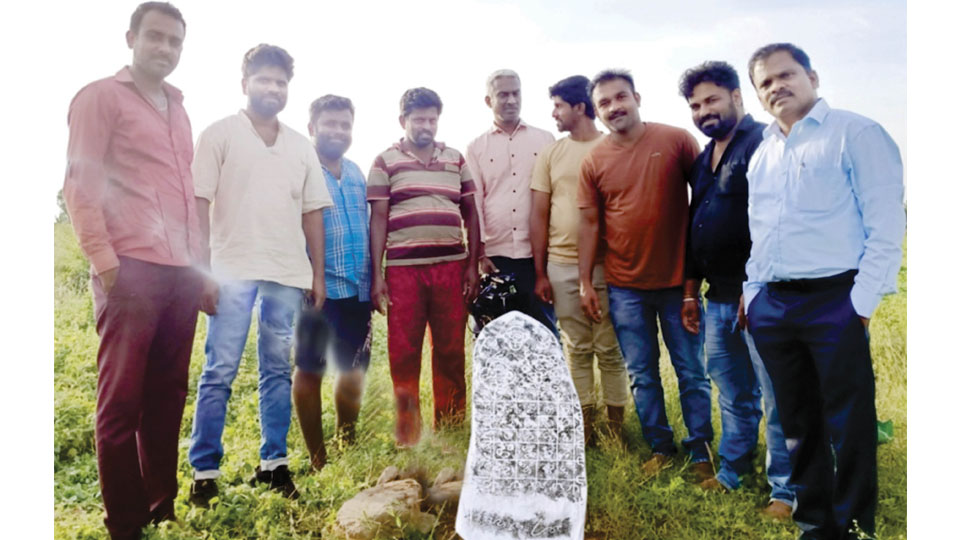Mysore/Mysuru: A team of researchers unearthed 16th century inscription stone with “MANTRA-TANTRA” at Machalaghatta in Nagamangala taluk, Mandya district recently.
It is a small hamlet, where stands Malleshwara Temple of Hoysala period and on the eastern side of the temple was found this half-hidden inscription. The research was conducted after obtaining permission from Dr. Shailendra Mohan, Director of Central Institute of Indian Languages (CIIL), Mysuru.
The research was carried out under the able guidance of Dr. C.A. Shashidhara, a Senior Research Fellow of Centre of Excellence for Studies in Classical Kannada (CESCK) along with Dr. R. Mariswamy.
Nature of Mantra Inscribed Stone
On the top of Mantra stone, there is a drawing of a deity, while the bottom has drawings of Vastumandalas. On the bottom square 5×4 houses (total 20 houses) there are Beeja Mantras like ‘Om’ and ‘Hreem’. It is noticed that the letters are in 16th and 17th century “Kannada Modi script”. Trishulas symbolising Rajoguna, Thamoguna and Sattvaguna are carved around it.
On the top of the stone there are drawings of Sun and Moon, indicating that the Sun will last as long as the Moon exists. “Urandakam” is written in ‘Tamil script’ at the bottom of the square houses with Beejaksharas.
To conduct this kind of research-oriented field work Dr. Pankaj Dvivedi, Assistant Director (Administration) and Dr. L.R. Premkumar, Head of Classical Language, CIIL, gave the administrative permission.
Tholkapian, Hoysalakumar and Sagar of CIIL and Shashikumar lent technical support for conducting field study and also for taking Estampage of the inscription. Apart from this, the locals named Ashoka, Prashanth, Divakara, Siddaraju and Kulla Marigowda co-operated in conducting the research.
The letters on the mantra-tantra stone found in Machalaghatta village are unique. It is a mantra stone with Modi script. In the past existed a practice of writing in Modi Script, besides the vernacular of common people. But it is special since such script is not found in the usual mantra stones. Such research studies have not been carried out in a proper manner earlier. The Centre should give more priority to these researches in the future. — Prof. N.S. Rangaraju, Senior Archaeologist
In earlier times, this kind of mantra stone was planted and worshipped at the entrances of the village with the intention that no evil spirit would affect their villages. In the past, epidemic diseases like cholera, smallpox and plague were claiming lives. Hence, a practice of installing this kind of mantra stone at the village entrances so that such infectious diseases do not affect the people and cattle. There was also this practice, where the enemies used to cast a spell on the entire town. With the intention of protecting village from such evil spirits, the villagers used to write such Beejaksharas using Mantra and Tantra. — Dr. C.A. Shashidhara, Senior Researcher, CESCK
The fear, apprehension and belief in Gods that existed in the minds of our forefathers can be understood through such unique ancient remains. This mantra stone is worshipped by locals with devotion even today and hence these kinds of ruins have remained. — Prof. Nilagiri M. Talwar, Project Director, CESCK
The script found on the stone is a 16th and 17th century “Kannada script”. As there is a trident around the squares, it is a mantra stone belonging to Shaivite sect. “Urandakam” is written on this mantra stone in ‘Tamil script’, which may be the name of the sculptor who carved it or the name of the priest. —Dr. Sangamesh Kalyani, Modi Script expert








Recent Comments